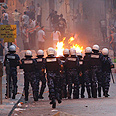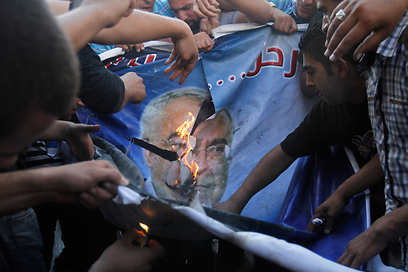
Time bomb under Israel's nose
Op-ed: Economic riots signal arrival of 'Arab Spring' train in Palestinian territories
"The Palestinian street was incited to riot not by Hamas, but by the people sitting here (members of Fatah and PFLP)…The diplomatic horizons have been blocked for three years now, since Netanyahu took power in Israel…The economic siege of the Palestinian Authority is applied first and foremost by the United States. I am willing to resign immediately and cancel the Oslo Accords"/ President Mahmoud Abbas after Palestinians burned photos of himself and of PM Fayyad during social protests across the West Bank, September 15, 2012.
About two weeks ago Palestinian newspapers in the West Bank reported that Fayyad's government has decided to cut fuel prices and VAT. Gasoline will now cost NIS 7.98 per liter ($2.04), but before you hurry to fill up your tank in the territories, know that the West Bank is a time bomb and that the reduced fuel prices cannot stop the "Arab Spring" train, which has already arrived in the PA.
The riots in the West Bank against the high cost of living include attempts at self-immolation, emulating Tunisian street vendor Mohamed Bouazizi, who sparked the "Arab Spring" when he set himself on fire in December 2010 after a policewoman confiscated his unlicensed vegetable cart and its goods.
Since the PA split into two entities in 2007 – Hamas in Gaza and Fatah in the West Bank – we've grown accustomed to hearing about the huge economic gap between the West Bank Palestinians and their brethren in the coastal enclave. The West Bank's economy is experiencing growth, while Gaza's economy is stuck in quicksand. So why did the riots erupt in the West Bank?
From the Arab world's perspective, the economic prosperity in the West Bank was nothing more than an intentional illusion meant to show the population in Gaza that wherever a pragmatic, pro-Western regime exists the residents prosper, while people living under Islamic rule are poor and oppressed.
But the reality is that the PA, headed by Abbas, is entirely dependent on external elements: Israel controls the territory, collects taxes and then transfers the money to the Authority; most revenues come from donations made by the US, EU, Saudi Arabia and the Gulf States. Since tens of thousands of Palestinians work in Israel, the West Bank's economy is heavily influenced by economic trends in Israel. The difference is that the average salary in the Palestinian territories is much lower than the average salary in Israel.

Demonstration in Hebron against high cost of living (Photo: AP)
The financial crisis, which led to unprecedented price hikes in the West Bank, is the result of the slowdown in Israel, the PA's credit crisis and its mounting debts, the increase in the price of fuel around the world, a drop in donations coming in from wealthy Arab countries, rampant tax evasion and more. Moreover, the PA's attempt to outdo Hamas vis-à-vis support for the families of Palestinians imprisoned in Israel and the families of "shahids (martyrs)" is also costing it a lot of money. The unemployment rate in the territories has reached nearly 17% over the past year (in Gaza the unemployment rate is twice as high). The Palestinians are mimicking the patterns of the "Arab Spring" according to the Jordanian model, which they are influenced by.
In Jordan residents called out against the monarchy in light of the economic crisis, and in the West Bank protesters called to overthrow Abbas' regime. Fatah officials have accused Hamas of fanning the flames in the West Bank, and a recent report in Al-Hayat claimed Hamas was offering money to the families of anyone who commits self-immolation.
Hamas spokesman Fawzi Barhoum accused the Palestinian leadership in the West Bank of promoting a policy that led to "political-economic bankruptcy." He said the crisis has exposed the 'Israeli trap' the PA has fallen into since the Oslo Accords. Hamas, like other Muslim Brotherhood offshoots in the Arab world, has accused the PA of corruption and says it ignores the people's suffering. About two weeks ago a Palestinian newspaper turned the public's attention to Abbas' designer shoes, a symbol of the leadership's wasteful spending.
However, Hamas' focus on the economic hardships in the West Bank may prove to be a double-edged sword. The economic crisis in Gaza is far more severe and the aid it receives, apparently from Iran and the Gulf States, is limited. It was recently reported that a Gaza resident also tried to set himself on fire.
Elements in the PA, as well as opposition groups in Gaza (particularly the PFLP) accuse Hamas of corruption and claim the Islamist group terrorizes the Strip's population. Egypt's campaign against terror organizations in Sinai is also hurting Gaza's economy. Last week dozens of Palestinians demonstrated near the Egyptian border against the closure of border crossings and accused Cairo of "suffocating the Strip."
The crisis in Gaza may spin out of control without significant outside intervention. The PA's collapse would lead to a third intifada with Hamas' backing. In case the riots in the West Bank spread to Gaza, the Hamas regime will also be threatened. In Gaza there are terrorist elements, such as al-Qaeda and the Salafis, who are waiting for Hamas' fall to intensify their anti-Israel activity.
Dr. Yaron Friedman is a graduate of the Sorbonne. He teaches Arabic and lectures about Islam at the Technion, at Beit Hagefen and at the Galilee Academic College. His book, the Nusayri Alawis: An Introduction to the Religion, History and Identity of the Leading Minority in Syria, was published in 2010 by Brill-Leiden










